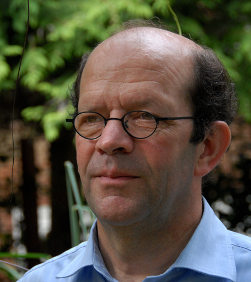

|
|
Invited Speakers
The following invited speakers will be presenting at WCNT 2011:
I: Factoring large numbers
II: Computations on zeta and other functions
Titles and Abstracts
| Paul Leyland (Brnikat Ltd, Cambridge, UK)
A History of Factoring in the Real World
The integer factorization problem has been been of interest to
mathematicians for well over two thousand years. For almost all of that
time, it was of almost no interest to any other section of society and
had almost no practical use whatsoever. In recent decades, integer
factorization has transformed itself into being of interest to
thousands, at least. It has also become of immense practical use and of
great economic importance. In my talk I will describe how and why this
remarkable change occurred. The emphasis will be on the economics,
politics and social impact rather than the underlying mathematics,
fascinating though that may be to mathematicians.
|
| Peter Montgomery (Microsoft Research, Redmond, WA, USA, and CWI)
Early History of the Number Field Sieve
The Number Field Sieve (NFS) demonstrated its power in 1990, when it factored a cofactor of the ninth Fermat number $2^{512}+1$. I joined Oregon State
University (OSU) 1992--1993 to research and implement NFS. The work continued at Centrum Wiskunde & Informatica (CWI) 1993--1994. In spring, 1994,
we completed two big factorizations started at OSU a year earlier. Soon we were swamped with results other algorithm had missed.
|
| Joppe Bos (EPFL, Switzerland)
Recent Developments in ECM
In this talk we outline how we obtained the 73-digit record factors using the fast parallel arithmetic designed to run on our PlayStation3 cluster inside a modified GMP-ECM implementation. Furthermore, we discuss some modifications to ECM when using Edwards curves on parallel architectures.
|
| Jason Papadopoulos (3S Group Inc.)
High-performance optimization of GNFS polynomials
Modern algorithms that search for polynomials for use with the General
Number Field Sieve now routinely generate candidates whose high-order
coefficients are very highly skewed. This drastically increases the
amount of work needed to further optimize both the size and root
properties of each candidate. I will describe several techniques that
can cope with the large search space and numerical difficulty that is
a consequence of large skewness, as implemented in the Msieve factorization
library. Examples will be given from a 2011 internet search for
a substitute to the polynomial used to factor RSA768 in 2010.
|
| Thorsten Kleinjung (EPFL, Switzerland)
Filtering and the matrix step in NFS
The matrix step is one of the main computational steps in NFS (number
field sieve). It is more difficult to parallelise than the other main
computational step (sieving), and its complexity depends on the outcome of
the filtering step.
For larger and larger numbers many matrix related problems arise.
These will be addressed in the talk and strategies to reduce
or circumvent them will be discussed.
|
| Alexander Kruppa (CWI, Amsterdam)
Comparison of the Block Wiedemann with the Block Lanczos algorithm for the linear algebra step in NFS
In the factorization of the 232-digit challenge number RSA768, which is the
current record for factoring general integers, the Block-Wiedemann method was
used for the linear algebra step of the General Number Field Sieve. Another
suitable algorithm for this step is the Block-Lanczos method, which has the
advantage of requiring fewer arithmetic operations in total but, unlike
Block-Wiedemann, cannot be distributed across several loosely connected systems.
We report on optimization efforts of the Block-Lanczos algorithm for the
Power6-based Huygens supercomputer at SARA, compare its performance to
Block-Wiedemann and evaluate its practical applicability to factorizations
of size like RSA768 and possibly larger.
|
| Joost Batenburg (Vision Lab, Univ. of Antwerp and CWI, Amsterdam)
Discrete tomography for lattice images: a journey through Mathematics
Tomography deals with the reconstruction of grey level images from their
projections. In discrete tomography, it is assumed that the unknown image
only contains grey levels from a small, discrete set. If one additionally
assumes that the image is defined on a discrete domain, we arrive at the
field of discrete tomography for lattice images.
Recently, tomography problems for lattice images have become of high practical
relevance, due to their applicability to the reconstruction of nanocrystals at
atomic resolution from projections obtained by electron microscopy.
Although the reconstruction problem for lattice images appears quite
elementary at first sight, it turns out to be both elegant and complex.
The problem has links with many different subfields of mathematics, ranging
from number theory and combinatorics to continuous optimization and analysis.
In each of these directions, interesting and sometimes surprising results
have been obtained during the past 10 years.
In this lecture I will illustrate the links of this tomography problem with
different fields from mathematics and highlight some important results,
followed by posing some new research questions that are currently unsolved.
|
| Pieter Moree (Max Planck Institute for Mathematics, Bonn, Germany)
Talk 1: The Erdős-Moser conjecture
The conjecture claims that the Diophantine
equation $1^k+...+(m-1)^k=m^k$ has only
$1^1+2^1=3^1$ as solution. Moser showed
by elementary arguments in 1953 that
if $(m,k)$ is a further solution, then
$k>10^{106}$. By a completely
different method involving the computation
of $\log 2$ with many digits of accuracy, Moser's
result was improved in 2011 to $m>10^{109}$.
This is joint work with Yves Gallot and Wadim
Zudilin and depends crucially on earlier work
by Herman te Riele.
Talk 2: Euler-Kronecker constants: from Ramanujan to Ihara
Given an $L$-series that has a series expansion around $s=1$
starting as $c_1(s-1)^{\alpha}+c_2+\ldots$, one
can define its Euler-Kronecker constant as
$c_2/c_1$. Ramanujan in his `unpublished' manuscript on the Ramanujan
tau-function made various conjectures on Euler-Kronecker constants.
In case the $L$-series is the Dedekind
zeta function, $\zeta_K(s)$, of a number field $K$ (in which case $\alpha=-1$), this constant has been intensively studied by Ihara (of the Ihara
zeta function) and his collaborators.
We show amongst others that, assuming some widely believed conjectures,
a conjecture made by Ihara in case $K={\Bbb Q}(\zeta_q)$ is a cyclotomic field, $q$ a prime, is false. We also deal with
the analogue of Ramanujan's conjectures for these fields.
(Joint work with Kevin Ford and Florian Luca.)
|
| Andrew Odlyzko (University of Minnesota, USA)
Computation and the Riemann Hypothesis
Extensive computations of zeros of the Riemann zeta function started
as soon as it was realized that the Riemann Hypothesis was an important
and a difficult problem. But the meaning of "extensive" changed with
improvements in algorithms and hardware, so the latest results cover 12 orders
of magnitude more than the earliest ones. What have we learned?
And what can we hope to learn?
|
| Rob Tijdeman (Leiden University)
Smooth numbers
Smooth numbers are numbers composed of (relatively) small primes.
They play an important part in many problems, for example with the factorization of large numbers. The number of positive integers at most x with all its prime factors less than y is usually denoted by the function \Psi (x,y).
Hardy and Littlewood and others gave formulas in case y is much smaller than x. Ramaswami and De Bruijn gave estimates in case y is a fixed power of x.
De Bruijn further indicated how both cases fit together around y= ln x.
I shall summarize the history and then go into later developments and variants to which former students of Herman te Riele and me have made some
contributions.
|
|

